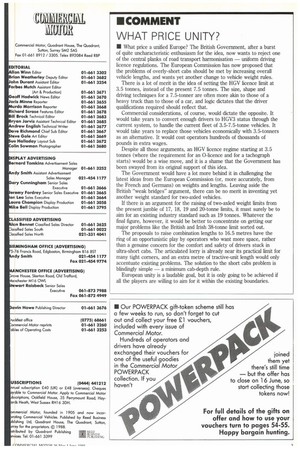WHAT PRICE UNITY?
Page 5

If you've noticed an error in this article please click here to report it so we can fix it.
• What price a unified Europe? The British Government, after a burst of quite uncharacteristic enthusiasm for the idea, now wants to reject one of the central planks of road transport harmonisation — uniform driving licence regulations. The European Commission has now proposed that the problems of overly-short cabs should be met by increasing overall vehicle lengths, and wants yet another change to vehicle weight rules.
There is a lot of merit in the idea of setting the HGV licence limit at 3.5 tonnes, instead of the present 7.5 tonnes. The size, shape and driving techniques for a 7.5-tonner are often more akin to those of a heavy truck than to those of a car, and logic dictates that the driver qualifications required should reflect that.
Commercial considerations, of course, would dictate the opposite. It would take years to convert enough drivers to HGV3 status through the current system, to handle the current fleet of 3.5-7.5-tonne vehicles. It would take years to replace those vehicles economically with 3.5-tonners as an alternative, It would cost operators hundreds of thousands of pounds in extra wages.
Despite all those arguments, an HGV licence regime starting at 3.5 tonnes (where the requirement for an 0-licence and for a tachograph starts) would be a wise move, and it is a shame that the Government has been swayed from its original support of this idea.
The Government would have a lot more behind it in challenging the latest ideas from the European Commission (or, more accurately, from the French and Germans) on weights and lengths. Leaving aside the British "weak bridges" argument, there can be no merit in inventing yet another weight standard for two-axled vehicles.
If there is an argument for the raising of two-axled weight limits from the present jumble of 17, 18, 19 and 20-tonne limits, it must surely be to aim for an existing industry standard such as 19 tonnes. Whatever the final figure, however, it would be better to concentrate on getting our major problems like the British and Irish 38-tonne limit sorted out.
The proposals to raise combination lengths to 16.5 metres have the ring of an opportunistic play by operators who want more space, rather than a genuine concern for the comfort and safety of drivers stuck in ultra-short cabs. The articulated lorry is already near its practical limit for many tight corners, and an extra metre of tractive-unit length would only accentuate existing problems. The solution to the short cabs problem is blindingly simple — a minimum cab-depth rule.
European unity is a laudable goal, but it is only going to be achieved if all the players are willing to aim for it within the existing boundaries.




































































































































